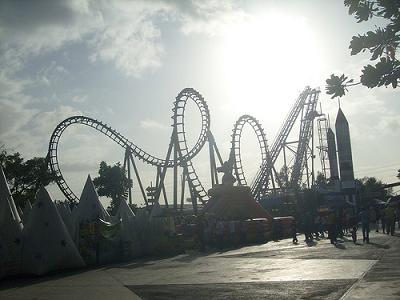However, roller coasters a more complicated than that. Much more complicated. With every roller coaster, the laws of physics are at play, both keeping you as safe as possible, and ensuring you didn't waste your money purchasing the admission tickets.
Most roller coasters rely on gravity to supply the car with the energy needed to complete the circuit. The car is winched up to the top of the first hill, supplying it with gravitational potential energy as it starts to come down the first drop. Some roller coasters use magnetic catapults to supply the car with kinetic energy. Magnets allow the roller coaster car to accelerate extremely fast and reach mind boggling speeds in a very short period of time.
Once the roller coaster is going around the track, you experience a lot of G-forces. You feel heavier if you are going up a hill and lighter if you are going down a hill. The rider also experiences centrifugal force when going around a tight turn, and acceleration when going down hills.
While the roller coaster is going around the track, it is not propelled by any motor. It travels all by itself, with its own momentum and gravity as its sole means of propulsion. In the end, just enough kinetic energy is supplied to your roller coaster car for it to make one complete circuit around the track.
Once you complete one circuit around the track, hydraulic brakes are usually used to stop the roller coaster car. The car experiences an acceleration in the direction opposite its motion.
Here are some related to roller coasters:



No comments:
Post a Comment